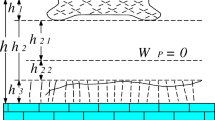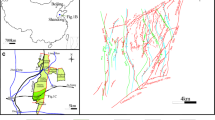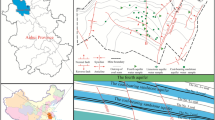Abstract
The unconsolidated Cenozoic formation is well developed in the Qidong coal mine. Water-inrushes from the bottom unconsolidated Cenozoic aquifer, which is the confined aquifer, have happened several times during mining in the north mining area of the Qidong coal mine. To predict the water-inrush risk areas in the south mining area of the Qidong coal mine where some working faces have just begun to mine, the engineering analogy method is used on basis of the Fisher’s discriminant model from the actual mining situation in the north mining area. Six main influence factors including the effective thickness, the specific yield, and the load transfer coefficient of the aquifer, the effective thickness of the protective bedrock layer, the fractal dimensional value of bedrock faults and the distance between the key hard stratum and the primary mineable coal seam are selected as discriminant indexes, and their corresponding data in the north mining area of the Qidong coal mine are served as training samples. On this basis, the Fisher’s discriminant model for water-inrush is established and water-inrush risk areas including the safety, the medium risk and the risk areas of no. 61, 82 and 9 primary mineable coal seams in the south mining area of the Qidong coal mine are predicted by the model. The model’s accuracy is 90.4 %, the scatter diagram of training samples shows obviously classified effect and the field verification indicates that the predicted type is consistent with the actual type. Results show that the discriminant model is well applied in the engineering analogy method and the water-inrush risk areas predicted by the discriminant model contribute to the subsequent mining in the south mining area in the Qidong coal mine.





Similar content being viewed by others
References
Bateni SM, Mortazavi-Naeini M, Ataie-Ashtiani B, Jeng DS, Khanbilvardi R (2015) Evaluation of methods for estimating aquifer hydraulic parameters. Appl Soft Comput 28:541–549
Booth CJ (1986) Strata-movement concepts and the hydrogeological impact of underground coal mining. Ground Water 24(4):507–515
Booth CJ, Bertsch LP (1999) Groundwater geochemistry in shallow aquifers above longwall mines in Illinois, USA. Hydrogeol J 7(6):561–575
Booth CJ, Spande ED (1992) Potentimetric and aquifer property changes above subsiding longwall mine panels, Illinois, USA. Hydrogeol J 7:561–575
Booth CJ, Curtiss AM, Demaris PJ, Bauer RA (2000) Site-specific variation in the potentiometric response to subsidence above active longwall mining. Environ Eng Geosci 6(4):383–394
Chen LW, Gui HR, Li YF (2007) UDEC simulation of the water-pouring probability in exploiting waterproof coal pillars under the conditions of thick loose bed and ultrathin overlying strata. Hydrogeol Eng Geol 34(1):53–56 (in Chinese)
Chen LW, Zhang SL, Gui HR (2014) Prevention of water and quicksand inrush during extracting contiguous coal seams under the lowermost aquifer in the unconsolidated Cenozoic alluvium—a case study. Arab J Geosci 7(6):2139–2149
Cheng C, Chen XH (2007) Evaluation of methods for determination of hydraulic properties in an aquifer–aquitard system hydrologically connected to a river. Hydrogeol J 15(4):669–678
Guo PK, Cheng YP, Jin K, Liu YP (2014) The impact of faults on the occurrence of coal bed methane in Renlou coal mine, Huaibei coalfield, China. J Nat Gas Sci Eng 17:151–158
He XB, Wang W, Yang YP, Yang YH (2009) Variable-weighted Fisher discriminant analysis for process fault diagnosis. J Process Contr 19(6):923–931
He ZF, Zhang YN, Guo QC, Zhao XR (2014) Comparative study of artificial neural networks and wavelet artificial neural networks for groundwater depth data forecasting with various curve fractal dimensions. Water Resour Manag 28:5297–5317
Hill JG, Price DR (1983) The impact of deep mining on an overlying aquifer in western Pennsylvania. Ground Water Monit R 3(1):138–143
Huang HF, Mao XB, Yao BH, Pu H (2012) Numerical simulation on fault water-inrush based on fluid-solid coupling theory. J Coal Sci Eng 18(3):291–296
Islam MR, Hayashi D, Kamruzzaman AB (2009) Finite element modeling of stress distributions and problems for multi-slice longwall mining in Bangladesh, with special reference to the Barapukuria coal mine. Int J Coal Geol 78(2):91–109
Ji Z, Jing PG, Yu TS, Su YT, Liu CS (2012) Ranking Fisher discriminant analysis. Neurocomputing 120:54–60
Kim JM, Parizek RR, Elsworth D (1997) Evaluation of fully-coupled strata deformation and groundwater flow in response to longwall mining. Int J Rock Mech Min 34(8):1187–1199
LaMoreaux JW, Wu Q, Zhou WF (2014) New development in theory and practice in mine water control in China. Carbonate Evaporite 29(2):141–145
Li B, Zhang PL, Wang ZJ, Mi SS, Liu PY (2012) Morphological covering based generalized dimension for gear fault diagnosis. Nonlinear Dynam 67(4):2561–2571
Li RZ, Wang Q, Wang XY, Liu XM, Li JL, Zhang YX (2015) Relationship analysis of the degree of fault complexity and the water irruption rate, based on fractal theory. Mine Water Environ. doi:10.1007/s10230-015-0348-2
Liu NP, Wang HT, Yuan ZG, Liu JC (2012) Fisher discriminant analysis model of sand liquefaction and its application. Rock Soil Mech 33(2):554–622 (in Chinese)
Mandelbrot BB, Wheeler JA (1982) The fractal geometry of nature. W. H. Freeman and company, San Francisco
Meng ZP, Gao YF, Lu AH, Wang R, Qiao X, Huang CY (2013) Water-inrush risk evaluation of coal mining under Quaternary alluvial water and reasonable design method of waterproof coal pillar. J Min Saf Eng 30(1):23–29 (in Chinese)
Miao XX, Cui XM, Wang JA, Xu JL (2011) The height of fractured water-conducting zone in undermined rock strata. Eng Geol 120:32–39
Sierra A (2002) High-order Fisher’s discriminant analysis. Pattern Recogn 35(6):1291–1302
Sui WH, Cai GT, Dong QH (2007) Experimental research on critical percolation gradient of quicksand a cross overburden fissures due to coal mining near unconsolidated soil layers. Chin J Rock Mech Eng 26(10):2084–2091 (in Chinese)
Tan JQ, Ju YW, Yuan WM, Hou QL, Pan JN, Fan JJ (2011) Thermochronological and structural evolution of the Huaibei coalfield in eastern China: constrains from zircon fission-track data. Radiat Meas 46(2):183–189
Wang XZ (2012) Study on occurrence condition and prevention of support crushing and water-inrush disaster during mining under unconsolidated confined aquifer. Dissertation. China University of Mining and Technology. (in Chinese)
Wang XZ, Xu JL, Zhu WB, Li YC (2012) Roof pre-blasting to prevent support crushing and water-inrush accidents. Int J Min Sci Technol 22(3):379–384
Wang HF, Wang L, Cheng YP, Zhou HX (2013) Characteristics and dominant controlling factors of gas outburst in Huaibei coalfeld and its countermeasures. Int J Min Sci Technol 23:591–596
Wu Q, Zhou WF (2008) Prediction of inflow from overlying aquifers into coalmines: a case study in Jinggezhuang Coalmine, Kailuan, China. Envrion Geol 55(4):775–780
Wu SY, Hu BL, Yao DX, Zhang DS (2010) Analysis on geological structures influencing gas occurrence at Qidong coalmine. J Coal Sci Eng 16(3):292–295
Wu Q, Fan ZL, Zhang ZW, Zhou WF (2014) Evaluation and zoning of groundwater hazards in Pingshuo No. 1 underground coal mine, Shanxi Province, China. Hydrogeol J 22(7):1693–1705
Wu Q, Liu YZ, Luo LH, Liu SQ, Sun WJ, Zeng YF (2015) Quantitative evaluation and prediction of water-inrush vulnerability from aquifers overlying coal seams in Donghuantuo coal mine, China. Environ Earth Sci 74:1429–1437
Xu JL, Zhu WB, Wang XZ (2011) Study on water-inrush mechanism and prevention during coal mining under unconsolidated confined aquifer. J Min Saf Eng 28(3):333–339 (in Chinese)
Xu JL, Zhu WB, Wang XZ (2012) New method to predict the height of fractured water-conducting zone by location of key strata. J Chin Coal Soc 37(5):762–769 (in Chinese)
Yu BH (2009) Study on the hazard-formation mechanism of key strata compound breaking mining under unconsolidated confined aquifer with high water pressure. Dissertation. China University of Mining and Technology. (in Chinese)
Zhang JC, Peng SP (2005) Water-inrush and environmental impact of shallow seam mining. Eng Geol 48(8):1068–1076
Zhang JC, Shen BH (2004) Coal mining under aquifers in China: a case study. Int J Rock Mech Min 41(4):629–639
Zhang WJ, Zhong XQ, Liu GH (2008) Recognizing spatial distribution patterns of grassland insects: neural network approaches. Stoch Env Res Risk A 22(2):207–216
Zhang HQ, He YN, Tang CA, Ahmad B, Han LJ (2009) Application of an improved flow-stress-damage model to the criticality assessment of water-inrush in a mine: a case study. Rock Mech Rock Eng 42(6):911–930
Zhang DS, Fan GW, Ma LQ, Wang XF (2011) Aquifer protection during longwall mining of shallow coal seams: a case study in the Shendong Coalfield of China. Int J Coal Geol 86:90–196
Zhang GM, Zhang K, Wang LJ, Wu Y (2015) Mechanism of water-inrush and quicksand movement induced by a borehole and measures for prevention and remediation. B Eng Geol Environ. 74(4):1395–1405
Acknowledgments
This work is financially supported by the National Natural Science Foundation of China (No. 41372244, 41172216, 41373095) and the Anhui Natural Science Foundation of China (No. 1308085ME61). The authors would like to express sincere thanks to the reviewers for their thorough reviews and useful suggestions.
Author information
Authors and Affiliations
Corresponding author
Rights and permissions
About this article
Cite this article
Chen, L., Feng, X., Xie, W. et al. Prediction of water-inrush risk areas in process of mining under the unconsolidated and confined aquifer: a case study from the Qidong coal mine in China. Environ Earth Sci 75, 706 (2016). https://doi.org/10.1007/s12665-016-5533-5
Received:
Accepted:
Published:
DOI: https://doi.org/10.1007/s12665-016-5533-5




